Cryptocurrency Systems: Security Issues - Annotated Bibliography
VerifiedAdded on 2023/06/10
|5
|1123
|121
Annotated Bibliography
AI Summary
This annotated bibliography provides an overview of cryptocurrency, focusing on its evolution, security concerns, and underlying blockchain technology. It references key articles discussing the adoption of blockchain systems, the security vulnerabilities within cryptocurrency networks, and the potential for misuse. The bibliography also covers the basics of cryptocurrencies, their features, and their impact on traditional economic paradigms. Furthermore, it highlights research tutorials aimed at bridging the gap between IT research and cryptographic currencies, offering insights into the risks and opportunities associated with cryptocurrency investments. Desklib offers this and many more solved assignments for students.
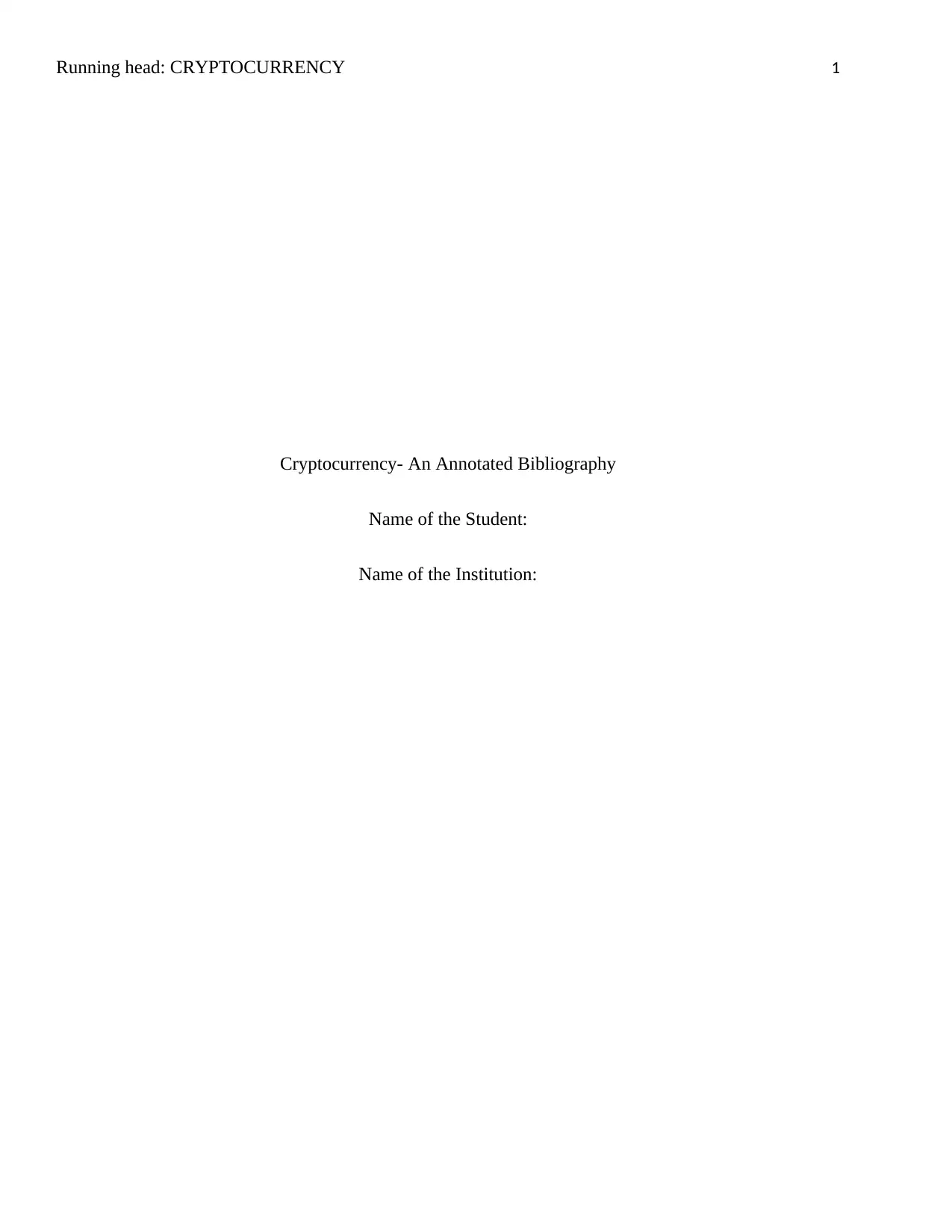
Running head: CRYPTOCURRENCY 1
Cryptocurrency- An Annotated Bibliography
Name of the Student:
Name of the Institution:
Cryptocurrency- An Annotated Bibliography
Name of the Student:
Name of the Institution:
Paraphrase This Document
Need a fresh take? Get an instant paraphrase of this document with our AI Paraphraser
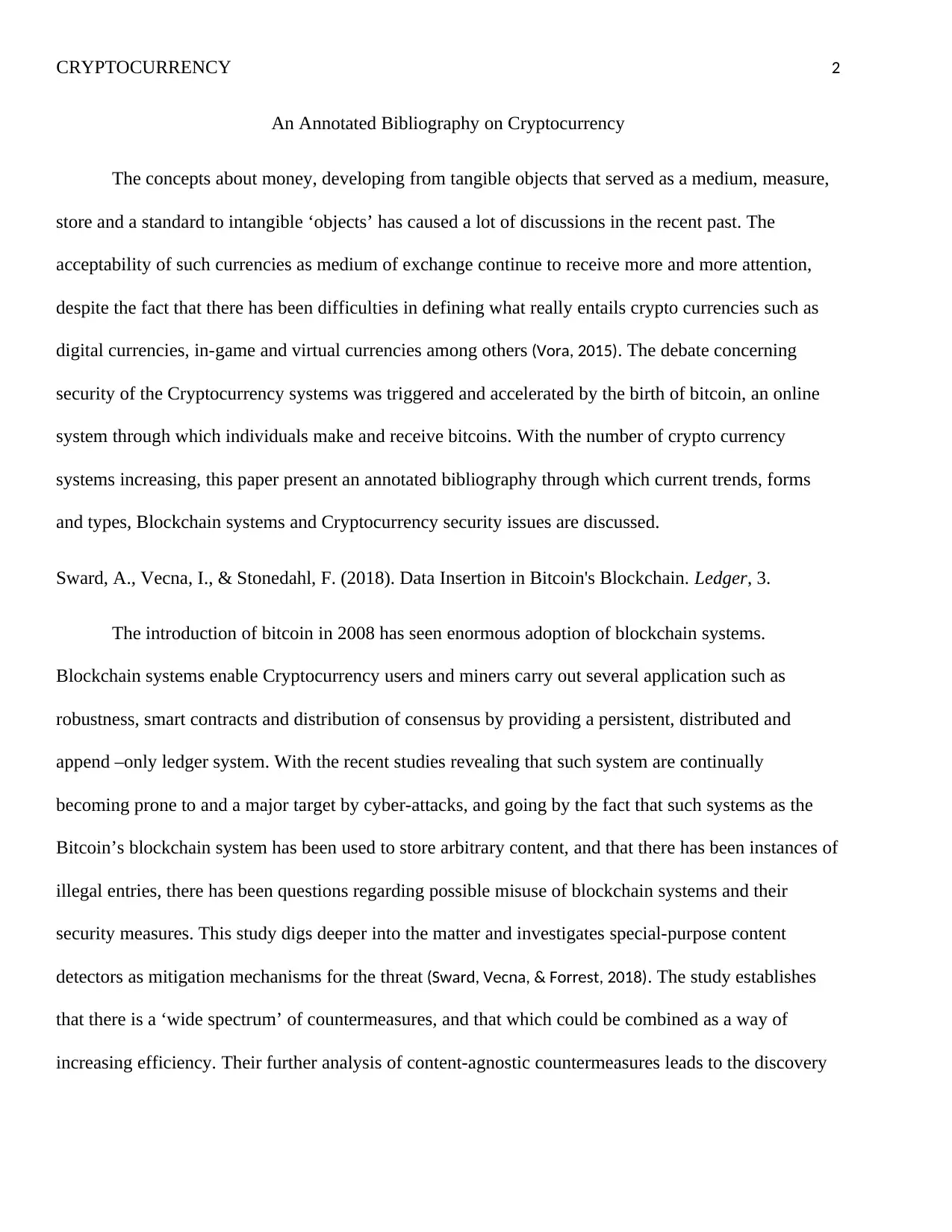
CRYPTOCURRENCY 2
An Annotated Bibliography on Cryptocurrency
The concepts about money, developing from tangible objects that served as a medium, measure,
store and a standard to intangible ‘objects’ has caused a lot of discussions in the recent past. The
acceptability of such currencies as medium of exchange continue to receive more and more attention,
despite the fact that there has been difficulties in defining what really entails crypto currencies such as
digital currencies, in-game and virtual currencies among others (Vora, 2015). The debate concerning
security of the Cryptocurrency systems was triggered and accelerated by the birth of bitcoin, an online
system through which individuals make and receive bitcoins. With the number of crypto currency
systems increasing, this paper present an annotated bibliography through which current trends, forms
and types, Blockchain systems and Cryptocurrency security issues are discussed.
Sward, A., Vecna, I., & Stonedahl, F. (2018). Data Insertion in Bitcoin's Blockchain. Ledger, 3.
The introduction of bitcoin in 2008 has seen enormous adoption of blockchain systems.
Blockchain systems enable Cryptocurrency users and miners carry out several application such as
robustness, smart contracts and distribution of consensus by providing a persistent, distributed and
append –only ledger system. With the recent studies revealing that such system are continually
becoming prone to and a major target by cyber-attacks, and going by the fact that such systems as the
Bitcoin’s blockchain system has been used to store arbitrary content, and that there has been instances of
illegal entries, there has been questions regarding possible misuse of blockchain systems and their
security measures. This study digs deeper into the matter and investigates special-purpose content
detectors as mitigation mechanisms for the threat (Sward, Vecna, & Forrest, 2018). The study establishes
that there is a ‘wide spectrum’ of countermeasures, and that which could be combined as a way of
increasing efficiency. Their further analysis of content-agnostic countermeasures leads to the discovery
An Annotated Bibliography on Cryptocurrency
The concepts about money, developing from tangible objects that served as a medium, measure,
store and a standard to intangible ‘objects’ has caused a lot of discussions in the recent past. The
acceptability of such currencies as medium of exchange continue to receive more and more attention,
despite the fact that there has been difficulties in defining what really entails crypto currencies such as
digital currencies, in-game and virtual currencies among others (Vora, 2015). The debate concerning
security of the Cryptocurrency systems was triggered and accelerated by the birth of bitcoin, an online
system through which individuals make and receive bitcoins. With the number of crypto currency
systems increasing, this paper present an annotated bibliography through which current trends, forms
and types, Blockchain systems and Cryptocurrency security issues are discussed.
Sward, A., Vecna, I., & Stonedahl, F. (2018). Data Insertion in Bitcoin's Blockchain. Ledger, 3.
The introduction of bitcoin in 2008 has seen enormous adoption of blockchain systems.
Blockchain systems enable Cryptocurrency users and miners carry out several application such as
robustness, smart contracts and distribution of consensus by providing a persistent, distributed and
append –only ledger system. With the recent studies revealing that such system are continually
becoming prone to and a major target by cyber-attacks, and going by the fact that such systems as the
Bitcoin’s blockchain system has been used to store arbitrary content, and that there has been instances of
illegal entries, there has been questions regarding possible misuse of blockchain systems and their
security measures. This study digs deeper into the matter and investigates special-purpose content
detectors as mitigation mechanisms for the threat (Sward, Vecna, & Forrest, 2018). The study establishes
that there is a ‘wide spectrum’ of countermeasures, and that which could be combined as a way of
increasing efficiency. Their further analysis of content-agnostic countermeasures leads to the discovery
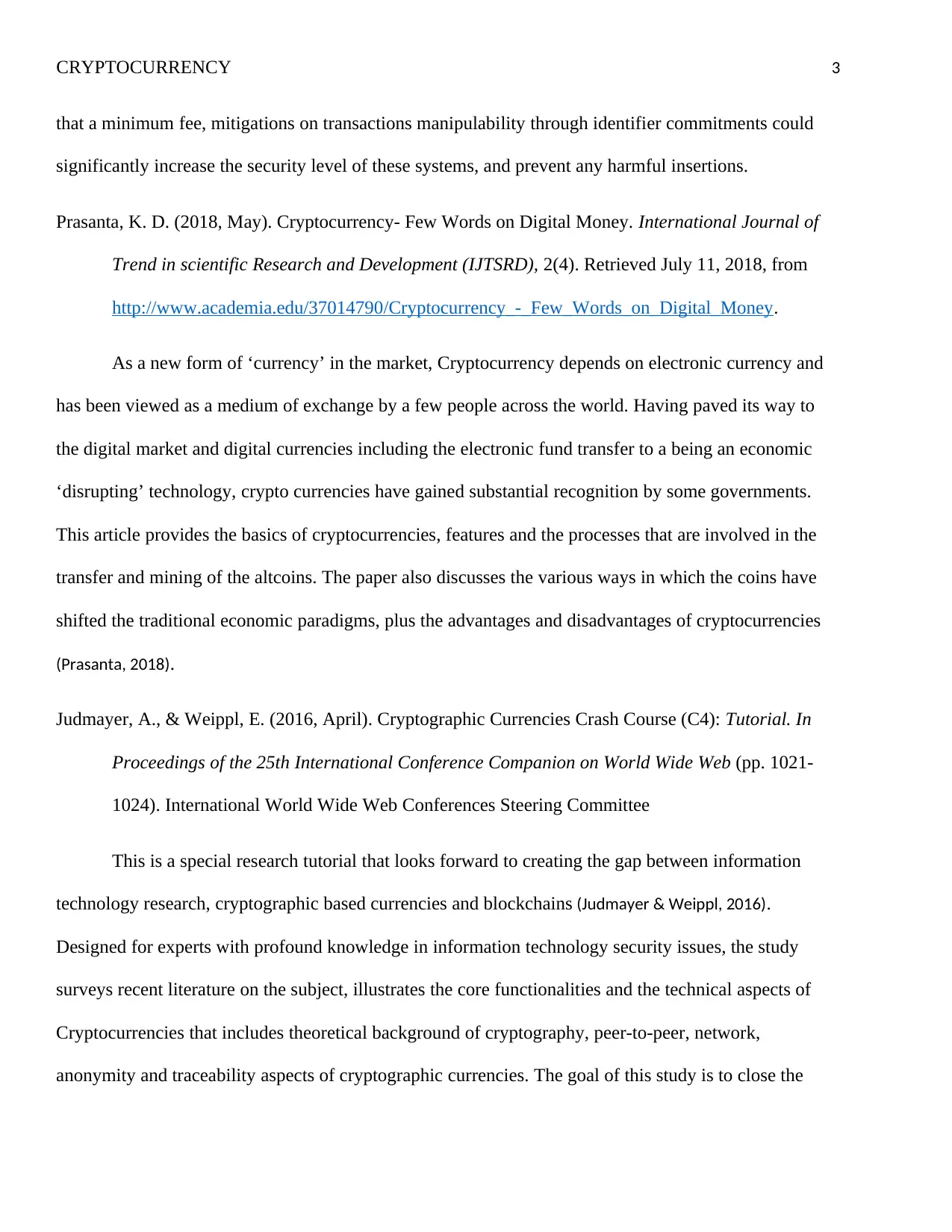
CRYPTOCURRENCY 3
that a minimum fee, mitigations on transactions manipulability through identifier commitments could
significantly increase the security level of these systems, and prevent any harmful insertions.
Prasanta, K. D. (2018, May). Cryptocurrency- Few Words on Digital Money. International Journal of
Trend in scientific Research and Development (IJTSRD), 2(4). Retrieved July 11, 2018, from
http://www.academia.edu/37014790/Cryptocurrency_-_Few_Words_on_Digital_Money.
As a new form of ‘currency’ in the market, Cryptocurrency depends on electronic currency and
has been viewed as a medium of exchange by a few people across the world. Having paved its way to
the digital market and digital currencies including the electronic fund transfer to a being an economic
‘disrupting’ technology, crypto currencies have gained substantial recognition by some governments.
This article provides the basics of cryptocurrencies, features and the processes that are involved in the
transfer and mining of the altcoins. The paper also discusses the various ways in which the coins have
shifted the traditional economic paradigms, plus the advantages and disadvantages of cryptocurrencies
(Prasanta, 2018).
Judmayer, A., & Weippl, E. (2016, April). Cryptographic Currencies Crash Course (C4): Tutorial. In
Proceedings of the 25th International Conference Companion on World Wide Web (pp. 1021-
1024). International World Wide Web Conferences Steering Committee
This is a special research tutorial that looks forward to creating the gap between information
technology research, cryptographic based currencies and blockchains (Judmayer & Weippl, 2016).
Designed for experts with profound knowledge in information technology security issues, the study
surveys recent literature on the subject, illustrates the core functionalities and the technical aspects of
Cryptocurrencies that includes theoretical background of cryptography, peer-to-peer, network,
anonymity and traceability aspects of cryptographic currencies. The goal of this study is to close the
that a minimum fee, mitigations on transactions manipulability through identifier commitments could
significantly increase the security level of these systems, and prevent any harmful insertions.
Prasanta, K. D. (2018, May). Cryptocurrency- Few Words on Digital Money. International Journal of
Trend in scientific Research and Development (IJTSRD), 2(4). Retrieved July 11, 2018, from
http://www.academia.edu/37014790/Cryptocurrency_-_Few_Words_on_Digital_Money.
As a new form of ‘currency’ in the market, Cryptocurrency depends on electronic currency and
has been viewed as a medium of exchange by a few people across the world. Having paved its way to
the digital market and digital currencies including the electronic fund transfer to a being an economic
‘disrupting’ technology, crypto currencies have gained substantial recognition by some governments.
This article provides the basics of cryptocurrencies, features and the processes that are involved in the
transfer and mining of the altcoins. The paper also discusses the various ways in which the coins have
shifted the traditional economic paradigms, plus the advantages and disadvantages of cryptocurrencies
(Prasanta, 2018).
Judmayer, A., & Weippl, E. (2016, April). Cryptographic Currencies Crash Course (C4): Tutorial. In
Proceedings of the 25th International Conference Companion on World Wide Web (pp. 1021-
1024). International World Wide Web Conferences Steering Committee
This is a special research tutorial that looks forward to creating the gap between information
technology research, cryptographic based currencies and blockchains (Judmayer & Weippl, 2016).
Designed for experts with profound knowledge in information technology security issues, the study
surveys recent literature on the subject, illustrates the core functionalities and the technical aspects of
Cryptocurrencies that includes theoretical background of cryptography, peer-to-peer, network,
anonymity and traceability aspects of cryptographic currencies. The goal of this study is to close the
⊘ This is a preview!⊘
Do you want full access?
Subscribe today to unlock all pages.

Trusted by 1+ million students worldwide
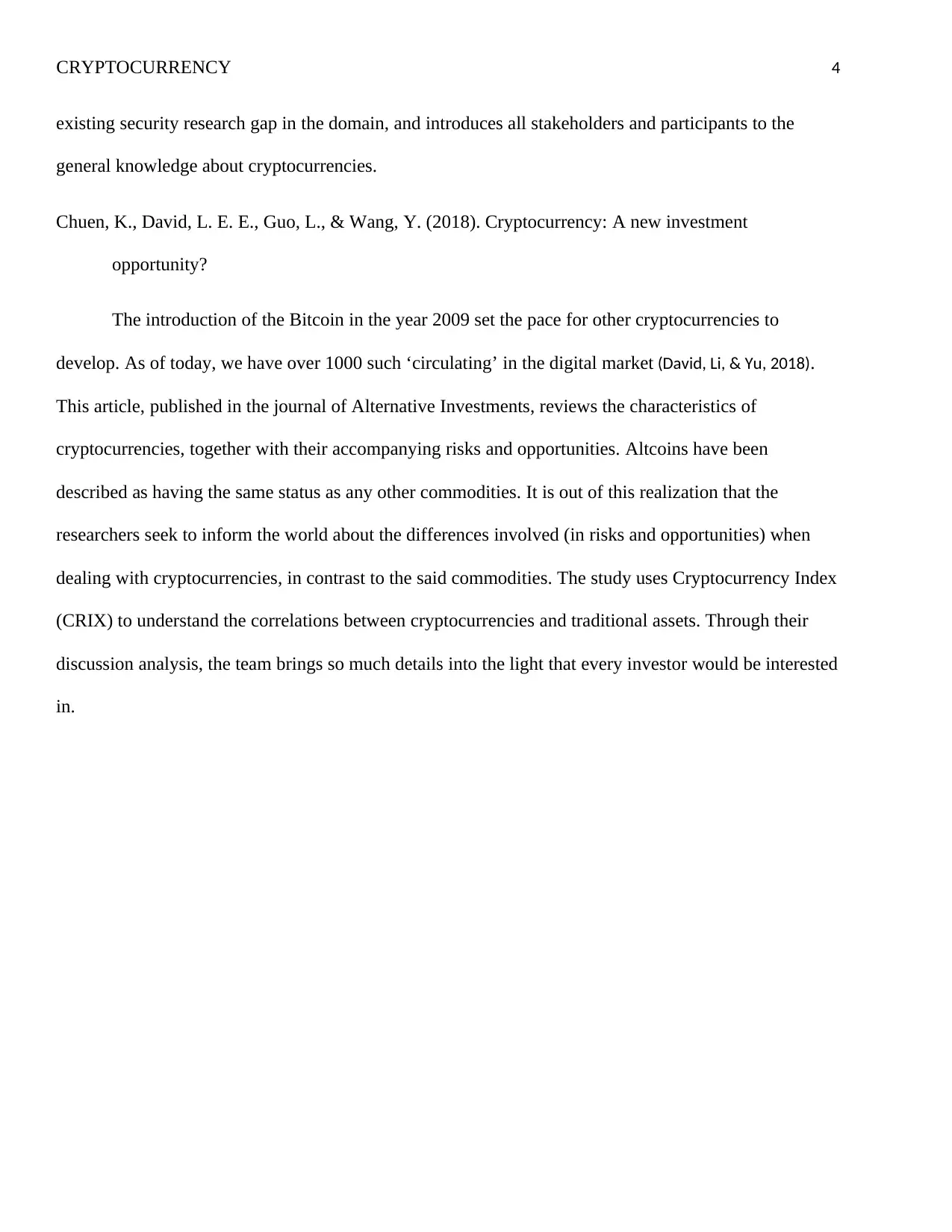
CRYPTOCURRENCY 4
existing security research gap in the domain, and introduces all stakeholders and participants to the
general knowledge about cryptocurrencies.
Chuen, K., David, L. E. E., Guo, L., & Wang, Y. (2018). Cryptocurrency: A new investment
opportunity?
The introduction of the Bitcoin in the year 2009 set the pace for other cryptocurrencies to
develop. As of today, we have over 1000 such ‘circulating’ in the digital market (David, Li, & Yu, 2018).
This article, published in the journal of Alternative Investments, reviews the characteristics of
cryptocurrencies, together with their accompanying risks and opportunities. Altcoins have been
described as having the same status as any other commodities. It is out of this realization that the
researchers seek to inform the world about the differences involved (in risks and opportunities) when
dealing with cryptocurrencies, in contrast to the said commodities. The study uses Cryptocurrency Index
(CRIX) to understand the correlations between cryptocurrencies and traditional assets. Through their
discussion analysis, the team brings so much details into the light that every investor would be interested
in.
existing security research gap in the domain, and introduces all stakeholders and participants to the
general knowledge about cryptocurrencies.
Chuen, K., David, L. E. E., Guo, L., & Wang, Y. (2018). Cryptocurrency: A new investment
opportunity?
The introduction of the Bitcoin in the year 2009 set the pace for other cryptocurrencies to
develop. As of today, we have over 1000 such ‘circulating’ in the digital market (David, Li, & Yu, 2018).
This article, published in the journal of Alternative Investments, reviews the characteristics of
cryptocurrencies, together with their accompanying risks and opportunities. Altcoins have been
described as having the same status as any other commodities. It is out of this realization that the
researchers seek to inform the world about the differences involved (in risks and opportunities) when
dealing with cryptocurrencies, in contrast to the said commodities. The study uses Cryptocurrency Index
(CRIX) to understand the correlations between cryptocurrencies and traditional assets. Through their
discussion analysis, the team brings so much details into the light that every investor would be interested
in.
Paraphrase This Document
Need a fresh take? Get an instant paraphrase of this document with our AI Paraphraser
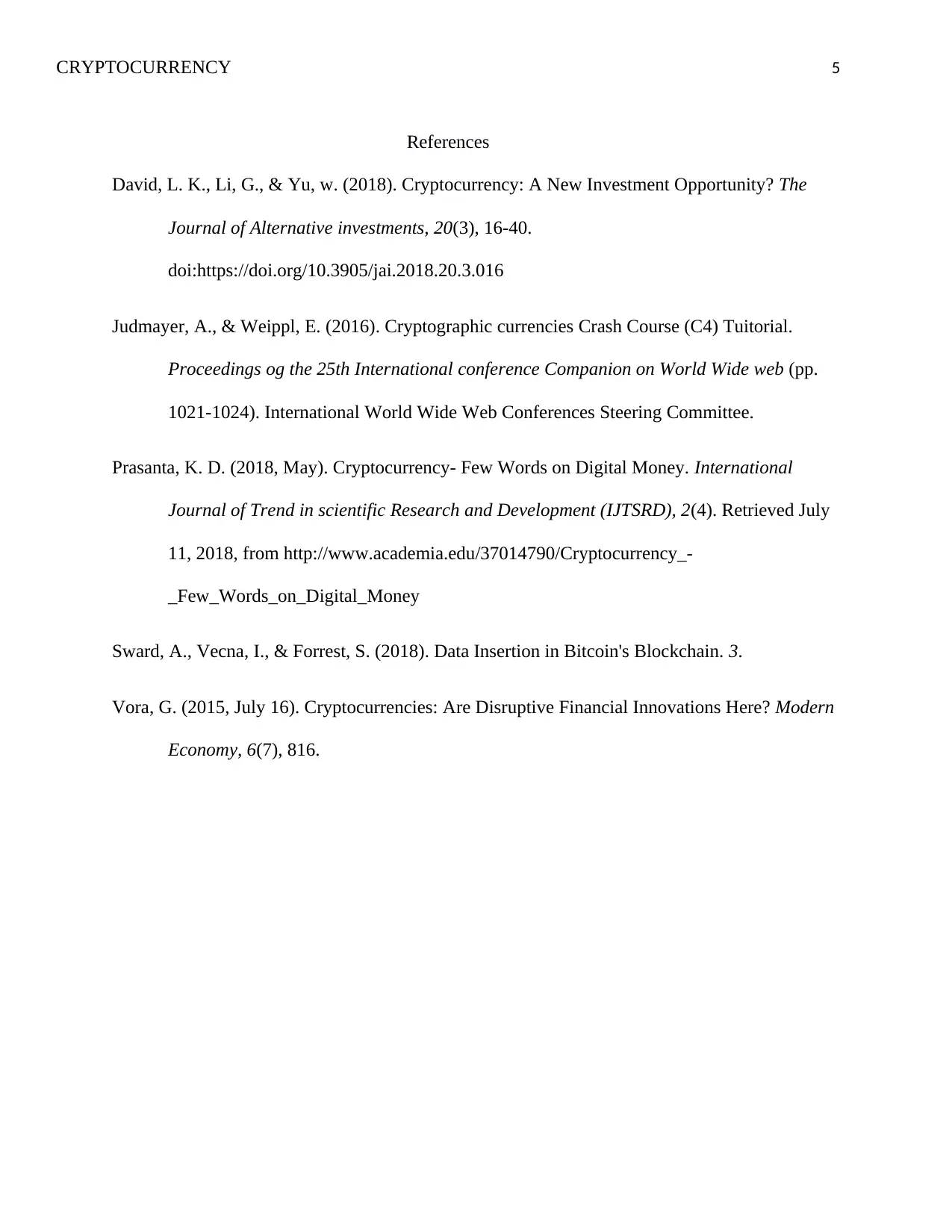
CRYPTOCURRENCY 5
References
David, L. K., Li, G., & Yu, w. (2018). Cryptocurrency: A New Investment Opportunity? The
Journal of Alternative investments, 20(3), 16-40.
doi:https://doi.org/10.3905/jai.2018.20.3.016
Judmayer, A., & Weippl, E. (2016). Cryptographic currencies Crash Course (C4) Tuitorial.
Proceedings og the 25th International conference Companion on World Wide web (pp.
1021-1024). International World Wide Web Conferences Steering Committee.
Prasanta, K. D. (2018, May). Cryptocurrency- Few Words on Digital Money. International
Journal of Trend in scientific Research and Development (IJTSRD), 2(4). Retrieved July
11, 2018, from http://www.academia.edu/37014790/Cryptocurrency_-
_Few_Words_on_Digital_Money
Sward, A., Vecna, I., & Forrest, S. (2018). Data Insertion in Bitcoin's Blockchain. 3.
Vora, G. (2015, July 16). Cryptocurrencies: Are Disruptive Financial Innovations Here? Modern
Economy, 6(7), 816.
References
David, L. K., Li, G., & Yu, w. (2018). Cryptocurrency: A New Investment Opportunity? The
Journal of Alternative investments, 20(3), 16-40.
doi:https://doi.org/10.3905/jai.2018.20.3.016
Judmayer, A., & Weippl, E. (2016). Cryptographic currencies Crash Course (C4) Tuitorial.
Proceedings og the 25th International conference Companion on World Wide web (pp.
1021-1024). International World Wide Web Conferences Steering Committee.
Prasanta, K. D. (2018, May). Cryptocurrency- Few Words on Digital Money. International
Journal of Trend in scientific Research and Development (IJTSRD), 2(4). Retrieved July
11, 2018, from http://www.academia.edu/37014790/Cryptocurrency_-
_Few_Words_on_Digital_Money
Sward, A., Vecna, I., & Forrest, S. (2018). Data Insertion in Bitcoin's Blockchain. 3.
Vora, G. (2015, July 16). Cryptocurrencies: Are Disruptive Financial Innovations Here? Modern
Economy, 6(7), 816.
1 out of 5
Related Documents
Your All-in-One AI-Powered Toolkit for Academic Success.
+13062052269
info@desklib.com
Available 24*7 on WhatsApp / Email
![[object Object]](/_next/static/media/star-bottom.7253800d.svg)
Unlock your academic potential
Copyright © 2020–2025 A2Z Services. All Rights Reserved. Developed and managed by ZUCOL.





